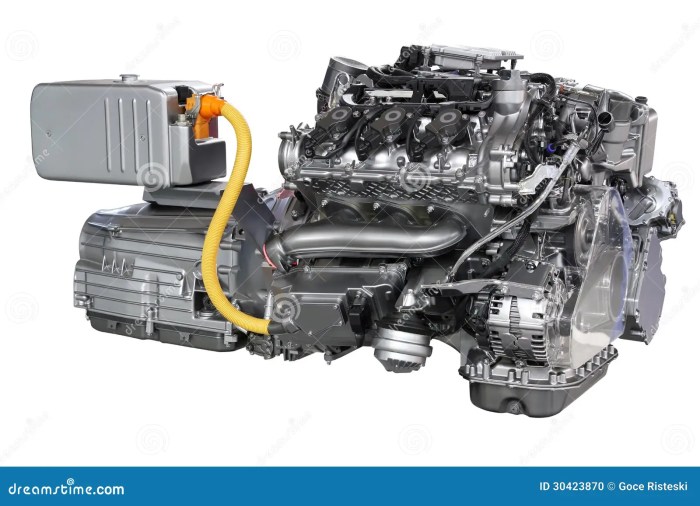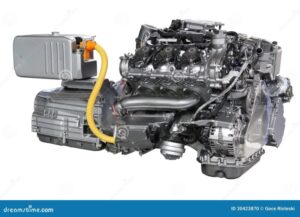
Hybrid engine performance stands at the intersection of technology and sustainability, capturing the attention of automotive enthusiasts and eco-conscious consumers alike. As the automotive industry evolves, the synergy between electric and traditional combustion engines is becoming increasingly significant, promising enhanced efficiency and reduced emissions.
This exploration delves into the core components that define hybrid engines, compares their performance with conventional engines, and examines how advancements in this technology are reshaping the landscape of automotive performance metrics.
Hybrid Engine Technology
Hybrid engine technology represents a significant advancement in the automotive field, combining traditional internal combustion engines with electric propulsion systems to enhance performance and fuel efficiency. This technology has gained traction in recent years, as automakers strive to meet stringent emissions regulations while also catering to consumers’ demand for eco-friendly options. By integrating multiple power sources, hybrid vehicles are designed to reduce reliance on fossil fuels, lower emissions, and provide a smoother driving experience.The fundamental components of hybrid engines include the internal combustion engine (ICE), electric motor, battery pack, and regenerative braking system.
The ICE generates power through the combustion of fuel, while the electric motor draws energy from the battery to assist with acceleration and other driving needs. The battery pack stores energy generated from both the electric motor and through regenerative braking, where kinetic energy from braking is converted back into electrical energy. These components work together seamlessly; the system can automatically switch between or combine power sources depending on driving conditions, optimizing performance and efficiency.
Comparison of Hybrid Engines and Traditional Combustion Engines
The differences between hybrid engines and traditional combustion engines can be significant, impacting various vehicle types including sedans, SUVs, and trucks. Understanding these distinctions is crucial for consumers evaluating their options.
- Fuel Efficiency: Hybrid engines typically offer better fuel economy than traditional combustion engines. For instance, a typical hybrid sedan can achieve over 50 miles per gallon, while many combustion engines average around 25-30 mpg for similar models.
- Emissions: Hybrid vehicles produce fewer greenhouse gas emissions compared to their traditional counterparts. This is due to the ability to operate on electric power at lower speeds and the efficiency of regenerative braking.
- Performance: While combustion engines may provide higher horsepower, hybrids often excel in torque delivery, particularly at low speeds, providing a more responsive driving experience.
- Cost of Ownership: Although hybrids may have a higher upfront cost, the savings on fuel and potential tax incentives can offset this over the vehicle’s lifespan.
Evolution of Hybrid Technology
The evolution of hybrid technology has transformed the automotive industry, impacting performance metrics and driving experience. Over the past two decades, hybrid technology has seen significant advancements, starting with early models like the Toyota Prius, which pioneered the market. The growth of hybrid technology can be categorized into several phases:
- First Generation: Early hybrids primarily focused on maximizing fuel efficiency without significant emphasis on performance. The integration of electric motors was basic, making these vehicles less powerful.
- Second Generation: Newer hybrids began incorporating advanced electric motors and improved battery technologies, resulting in enhanced performance metrics without sacrificing efficiency. Vehicles like the Honda Insight showcased these strides, balancing power and fuel economy.
- Current Trends: Modern hybrids now display features such as plug-in capabilities and sophisticated energy management systems. These innovations allow for greater electric-only driving ranges and enhanced performance metrics, appealing to a broader market.
The continuous evolution of hybrid technology has led to improvements in acceleration, responsiveness, and overall driving dynamics, making them a viable option for many consumers today.
“Hybrid technology not only represents a shift in engine design but also signifies a broader commitment to sustainable transportation solutions.”
Hybrid Engine Performance Metrics

Hybrid engines combine the best of both worlds—internal combustion and electric propulsion—to deliver improved fuel efficiency and performance. Evaluating hybrid engine performance involves examining various metrics that gauge their effectiveness in real-world scenarios. Understanding these metrics allows consumers and manufacturers to appreciate how hybrid technology contributes to sustainable mobility while maintaining power and responsiveness.
Key performance indicators (KPIs) for hybrid engine efficiency primarily include fuel economy, power output, and emissions. These metrics are essential for determining the overall effectiveness of hybrid engines in different driving conditions. Each metric provides valuable insights into how well hybrid vehicles perform compared to their traditional counterparts.
Key Performance Indicators Used to Evaluate Hybrid Engine Efficiency
Fuel economy, often measured in miles per gallon (MPG) or liters per 100 kilometers (L/100km), illustrates how efficiently a vehicle uses fuel. Hybrid engines frequently achieve superior fuel economy ratings compared to standard gasoline engines, leading to lower operating costs and reduced environmental impact. Another critical metric is power output, usually measured in horsepower or kilowatts, which indicates the vehicle’s ability to accelerate and maintain speed.
Lastly, emissions metrics, including CO2 and other greenhouse gases, reveal how hybrid engines contribute to cleaner air compared to conventional engines.
Real-world examples highlight the advantages of hybrid technology. The Toyota Prius, one of the most recognized hybrids, offers an impressive fuel economy of around 56 MPG in combined driving while providing adequate power for daily use. Another notable example is the Honda Accord Hybrid, which balances power and efficiency, delivering 48 MPG combined fuel economy alongside a 212-horsepower output. These vehicles exemplify how hybrids can deliver excellent performance without sacrificing fuel efficiency.
Adaptation of Hybrid Engines to Different Driving Conditions
Hybrid engines are designed to adapt to various driving conditions, optimizing performance outcomes based on real-time data. In urban settings, hybrid systems typically operate predominantly on electric power, significantly enhancing fuel efficiency during stop-and-go traffic. Conversely, on highways, the internal combustion engine often takes over, providing the necessary power for sustained speeds while maintaining efficient fuel consumption. This dual operation not only improves fuel economy but also minimizes emissions, contributing to a cleaner environment.
The transition between electric and gasoline power is seamless, aided by sophisticated control systems that assess factors such as speed, acceleration, and battery state. For instance, during heavy acceleration, the gasoline engine provides additional power, while regenerative braking captures energy during deceleration to recharge the battery. This adaptive capability enables hybrid engines to perform optimally regardless of driving conditions, enhancing both the driving experience and the vehicle’s efficiency.
In summary, hybrid engines represent a significant advancement in automotive technology, characterized by metrics such as fuel economy, power output, and emissions. As real-world examples illustrate, hybrids can deliver remarkable efficiency and performance, while their adaptability to various driving conditions ensures they meet the diverse needs of modern drivers.
Legal and Regulatory Issues Surrounding Hybrid Engines
The hybrid engine market faces a myriad of legal and regulatory challenges that can significantly impact both manufacturers and consumers. Navigating these complexities is essential for ensuring compliance and fostering innovation. As these vehicles become more prevalent, understanding the implications of laws and regulations on hybrid technology becomes increasingly important.Various legal challenges emerge in the hybrid engine market, particularly regarding performance standards set by governmental agencies.
Manufacturers must comply with stringent performance metrics that aim to ensure safety, efficiency, and environmental protection. These challenges can delay the introduction of new technologies, as companies invest considerable resources into meeting compliance requirements. One key aspect is the varying performance standards across regions, which can complicate international sales and manufacturing strategies.
Environmental Regulations Impacting Hybrid Engine Development
Environmental regulations play a crucial role in shaping the development of hybrid engines. These regulations are designed to minimize carbon emissions and promote sustainable practices within the automotive industry. The impact of these regulations can both foster innovation and pose challenges to performance capabilities.Manufacturers must adhere to specific emissions standards that dictate the allowable levels of pollutants, such as nitrogen oxides and particulate matter.
The following points highlight the implications of these regulations on hybrid engine development:
- Compliance with emissions standards often necessitates the integration of advanced technologies, which can lead to improved fuel efficiency and reduced environmental impact.
- Stringent regulations may limit the performance capabilities of hybrid engines, as manufacturers balance power output with compliance to avoid penalties.
- Incentivized research and development can arise from regulatory frameworks, promoting innovations like regenerative braking and lightweight materials that enhance overall performance.
The legal landscape is also shaped by regional differences in regulatory frameworks. Different countries or regions may offer varying degrees of incentives for hybrid engine adoption, influencing manufacturer strategies and consumer behavior.
Comparison of Incentives and Regulations Across Regions
The incentives and regulations for hybrid engines vary widely across the globe, which can either foster or hinder innovation within the market. Understanding these disparities is essential for manufacturers looking to expand their reach and optimize their offerings.Incentives, such as tax credits and rebates for consumers purchasing hybrid vehicles, can significantly boost sales and encourage manufacturers to invest in hybrid technology.
However, these incentives are not uniform. Here are some notable examples:
- In the United States, federal tax credits for hybrid purchases can go up to $7,500, encouraging consumers to choose environmentally friendly options.
- In European countries, stringent emissions targets are coupled with incentives for electric and hybrid vehicles, pushing manufacturers to develop more efficient technologies.
- Conversely, some regions may impose heavy taxes on hybrid vehicles, which can deter consumers and slow down market growth.
In addition to incentives, regulations on vehicle emissions and fuel efficiency can vary significantly, affecting how hybrid engines are designed and marketed. These differences can lead to inconsistencies in performance standards, making it essential for manufacturers to stay informed about regional legal requirements.
Understanding the legal and regulatory landscape is crucial for hybrid engine manufacturers to thrive in a competitive market.
Epilogue

In conclusion, the journey through hybrid engine performance reveals a dynamic field that not only boosts fuel efficiency but also paves the way for future innovations in automotive design. As regulatory pressures mount and consumer preferences shift, hybrid technology is poised to remain at the forefront of the automotive industry, delivering impressive performance while addressing environmental concerns.
FAQ Guide
What are the main components of a hybrid engine?
A hybrid engine typically consists of an internal combustion engine, an electric motor, a battery pack, and a control system that manages the interaction between the two power sources.
How do hybrid engines compare in fuel efficiency to traditional engines?
Hybrid engines generally offer better fuel efficiency than traditional combustion engines due to their ability to switch between power sources and utilize regenerative braking.
Can hybrid cars perform well in different driving conditions?
Yes, hybrid vehicles are designed to adapt to various driving conditions, optimizing performance whether in stop-and-go traffic or on the highway.
Are there any incentives for purchasing hybrid vehicles?
Many regions offer tax incentives, rebates, or grants to encourage the purchase of hybrid vehicles, supporting both consumers and manufacturers.
What impact do environmental regulations have on hybrid engine development?
Environmental regulations often drive innovation in hybrid engines, pushing manufacturers to enhance performance and reduce emissions to meet stricter standards.





